 Materials
Materials2 skeins Cleckheaton “Angora Supreme” 152 yds/139 mtrs per 50 grams. 70% lambswool and 30% angora. Held double. Listed as aran weight. Any bulky yarn may be substituted. Set of #11 double point needles (5 per set). Mine measures halfway between #11 & #13, stitch holder, darning needle
Gauge in garter stitch: 3 sts & 5.33 rows per 1”
Leg Cast on 29 sts in k2 p2 rib. Join, knitting the last k st together with 1st knit stitch of round to avoid a jog.
Continue in k2p2 for 2”. Begin dec. st. at beginning and at end of round every five rounds until 22 sts remain. At 5” begin garter pattern by purling a round, then knitting the next. (Continue to alternate k and p rounds thusly until the end of the toe.) After 1st garter ridge dec. again at beginning & end of round (20 sts. remain)
Heel After 5 ridges begin the short row heel at beginning of round. Row 1. k4, wrap 1 stitch, turn, keeping the garter stitch pattern.
Note: the heel sts will reflect that they are the beginning and end of the round so that the stitches from the 1st needle will be knit while the sts from the last needle (4th needle if using 5 needle set or 3rd needle if using 4 needle set) will be purled and vice versa. If you can use the center jog as a visual cue for switching between k & p, you can put the heel sts all on one needle but if you are concerned about getting confused, keep them on 2 needles (the 1st and 4th)
Row 2 K/P 8 sts, wrap 1 then turn.
Row 3 : K/P 7 sts, wrap 1 then turn
Rows 4-6 continue decreasing by 1 the k/p stitches before wrapping & turning
Rows 7 & 8: repeat Row 6 (k/p 1, k4, wrap & turn)
Row 9 K/P 5, wrap & turn.
Note: the 5th stitch in row 9 will have been wrapped. To avoid holes, pick up either the front or the back of the wrap and k/p with that stitch. Continue thusly as you pick up the sts previously wrapped. It helps to knit wrapped sts a little more tightly than the usual gauge.
Rows 10-12, continue to pick up an addition st as well as the front or back of its wrap.
Finish the heel by picking up the last wrapped st on the first needle and continue with the round. When you get to the beginning of the last needle, pick up one st from the hole that has been created by all the wrapping & turning. Pick up the 1st st on needle #4 (or #3 if using a 4-needle set) as well as the front or back wrap and the heel is done. It may look a little dicey at this point but don’t worry, it can be fixed easily. It actually improves as you knit.
Foot For an average foot. this means about 6” of additional garter st. With the gauge above it’s 16 ridges until the toe. In the last row before the toe, dec 1 st at the beginning of needle #4 (or #3—see above). There are now 20 sts.
Toe In the k row after the last garter ridge, begin dec. every other row 1 st at beginning of needles (for 4 needles). If you are using 3 needles, k 2 tog, k3 four times. Continue dec at same st until 8 sts left. End with k row and kitchener st together.
Finishing If there are big holes at the sides of the heel, pull gently together on inside with extra yarn & darning needle. Sew in cast on and toe threads.
Soles Can use leather or other devices, such as anti-slip carpet goo.
This is a fairly reversible sock, depending on how much you have to fix the holes on the sides of the heel. It is meant for a large foot and ankle. To modify for smaller feet, adjust the gauge by changing needle sizing down.
(c) Elizabeth F. Stabler. This pattern is available for personal use but may not be used commercially for profit or reproduced in any way without my express written permission.

No comments:
Post a Comment